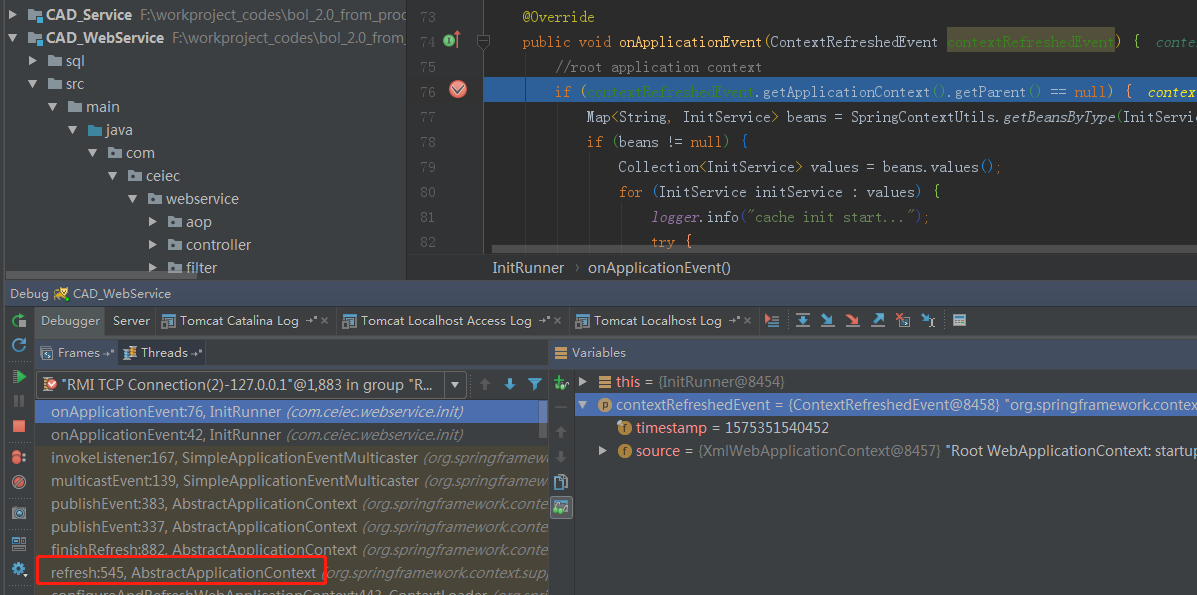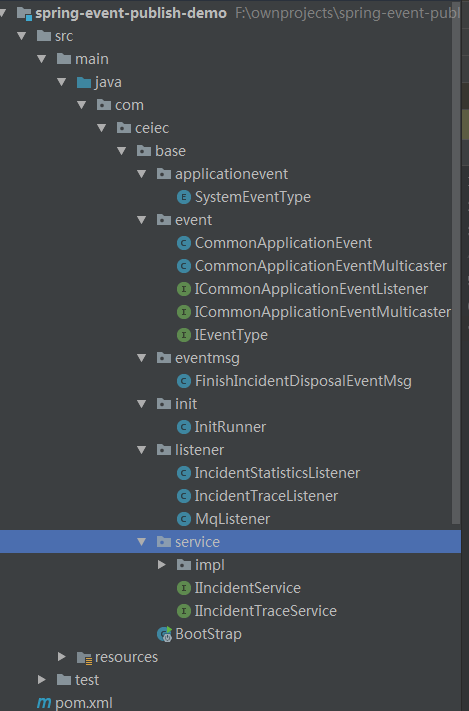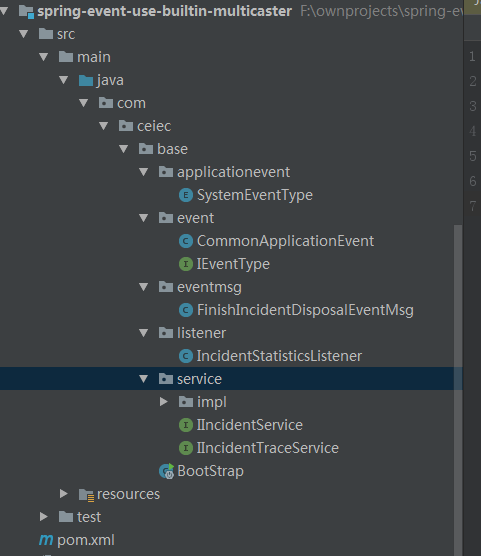从spring源码汲取营养:模仿spring事件发布机制,解耦业务代码
前言
最近在项目中做了一项优化,对业务代码进行解耦。我们部门做的是警用系统,通俗的说,可理解为110报警。一条警情,会先后经过接警员、处警调度员、一线警员,警情是需要记录每一步的日志,是要可追溯的,比如报警人张小三在2019-12-02 00:02:01时间报警,接警员A在1分钟后,将该警情记录完成,并分派给处警调度员B,调度员B在5分钟后,分派给一线警员C,C赶到现场后,花了1个小时处理完成。
这中间,每一个接口,需要做的事情,可能就包括了:警情日志记录;警员当前任务数统计,包括待处置的任务和已经处置完成的任务;我们其实还有一个操作,就是发mq,去通知其他相关人,比如接警员A接警完成后,要发mq通知其主管。
以前的代码可能是这样的:
## 接口1里, 接收警情service里完成以下操作
void 接收警情(xxxReqVo reqVo){
1:写库
2:记录警情跟踪日志
3:增加当前接警员的接警数
4:发mq通知其他相关人
}
##接口2里,分派警情的service里完成以下操作
void 分派警情(xxxReqVo reqVo){
1:写库
2:记录警情跟踪日志
3:增加当前处警调度警员的处警数
4:发mq通知其他相关人
}
这样的问题是什么呢?
- 在每一个相关接口里,都要“显式”调用:记录跟踪日志的相关方法、统计相关的方法、发mq相关的方法;但凡有一个地方忘记了,都会导致问题,比如统计数量不准,mq忘发,跟踪日志遗漏等。
- 业务逻辑和这类通用业务揉在一起,假设下次又需要给报警人发个短信,岂不是又得去改核心代码?这不符合我们“对修改关闭,对扩展开放”的开闭原则啊;假设脑残的产品经理,这次说要给报警人发短信,过两天又不要了,难道每个接口,挨个挨个改吗,想想都想打死产品经理,但是这个又犯法,还是想想其他办法?
这个问题,我们可以用类似mq的方法来解决,即,发送消息,各个消费者去消费。一般,mq的方式适用于微服务之间,而我们这里,将使用事件-发布机制来解决这个问题。
源码地址(直接dubug跟一下,很简单,比看文章来得快):
https://gitee.com/ckl111/spring-event-publish-demo
先说说ApplicationListener
在spring boot之前的spring 时代,想必一些同学用过org.springframework.context.ApplicationListener,正好我手里有一个老项目,也用到了这个东西,我就拿这个举个例子:
在我们的项目中,需要在启动后,初始化一些东西,比如预热缓存,最早的代码呢,可能是大家各自实现org.springframework.beans.factory.InitializingBean,但是这样呢,初始化代码散落在各个service中;还有一些直接使用@PostContruct注解,然后在对应方法里去完成一些初始化操作。但是总体来说,这些方式,在spring的启动过程中,被调用的时机比较靠前,有些候某些bean可能还没初始化完成,而导致一些奇怪的问题。
所以,我们后来统一去掉了这些初始化代码,全部采用以下机制来实现:
import org.springframework.context.ApplicationListener;
import org.springframework.context.event.ContextRefreshedEvent;
@Service
public class InitRunner implements ApplicationListener<ContextRefreshedEvent> {
@Autowired
private InitService initService;
@Override
public void onApplicationEvent(ContextRefreshedEvent contextRefreshedEvent) {
//root application context,因为是web项目,
if (contextRefreshedEvent.getApplicationContext().getParent() == null) {
initService.init();
}
}
在这个类中,我们实现了org.springframework.context.ApplicationListener<ContextRefreshedEvent> ,这个 listener的定义如下:
public interface ApplicationListener<E extends ApplicationEvent> extends EventListener {
/**
* Handle an application event.
* @param event the event to respond to
*/
void onApplicationEvent(E event);
}
接口 EventListener 是 jdk 的一个 marker interface:
package java.util;
/**
- A tagging interface that all event listener interfaces must extend.
- @since JDK1.1
*/
public interface EventListener {
}
我们在实现listener时,指定了本listener感兴趣的事件:ContextRefreshedEvent,这个事件的类继承关系如下:

那么,这个事件是什么意思呢?
/**
* Event raised when an {@code ApplicationContext} gets initialized or refreshed.
*
* @author Juergen Hoeller
* @since 04.03.2003
* @see ContextClosedEvent
*/
@SuppressWarnings("serial")
public class ContextRefreshedEvent extends ApplicationContextEvent {
/**
* Create a new ContextRefreshedEvent.
* @param source the {@code ApplicationContext} that has been initialized
* or refreshed (must not be {@code null})
*/
public ContextRefreshedEvent(ApplicationContext source) {
super(source);
}
}
注释说:Event raised when an {@code ApplicationContext} gets initialized or refreshed.,那么意思就是,该事件,是在上下文初始化完成后被发布。
这样的话,就能保证,在我们listener监听到这个事件的时候,整个应用上下文已经可以使用了。
一览Spring事件监听机制
我们再通过debug,来看看其真实的调用时机:

上图红框处,对spring上下文进行refresh,refresh就是spring 最核心的部分了,基本上,看懂了这个函数,就懂了一半:
// Prepare this context for refreshing.
prepareRefresh();
// Tell the subclass to refresh the internal bean factory.
ConfigurableListableBeanFactory beanFactory = obtainFreshBeanFactory();
// Prepare the bean factory for use in this context.
// 实例化beanFactory
prepareBeanFactory(beanFactory);
try {
// Allows post-processing of the bean factory in context subclasses.
// 对beanFactory进行处理
postProcessBeanFactory(beanFactory);
// Invoke factory processors registered as beans in the context.
// BeanFactoryPostProcessor开始作用的地方,这里会调用所有的beanFactory后置处理器
invokeBeanFactoryPostProcessors(beanFactory);
// Register bean processors that intercept bean creation.
// 注册 bean的后置处理器到beanFactory,注意,截止目前,还没开始实例化bean(除了少数几个内部bean)
registerBeanPostProcessors(beanFactory);
// Initialize message source for this context.
// 注册国际化相关bean
initMessageSource();
// Initialize event multicaster for this context.
// 注册事件发布器,这个和本文主题大有关系
initApplicationEventMulticaster();
// Initialize other special beans in specific context subclasses.
//注意上面这行注释,这个类是交给子类覆盖的,比如,在 org.springframework.web.context.support.AbstractRefreshableWebApplicationContext中,实例化了 org.springframework.ui.context.ThemeSource
onRefresh();
// Check for listener beans and register them.
// 从spring容器上下文中,查找ApplicationListener类型的监听器,添加到前两步,初始化的事件发布器中
registerListeners();
// Instantiate all remaining (non-lazy-init) singletons.
//注意:截止到目前为止,beanFactory里面基本还是空空如也,没有bean,只有BeanDefinition,在这一步才会 //根据那些BeanDefinition来实例化那些:非lazy-init的bean
finishBeanFactoryInitialization(beanFactory);
// Last step: publish corresponding event.
// 发布:容器完成初始化的事件
finishRefresh();
}
上面基本都加了注释,比较容易懂,需要重点关注的是:
- 事件发布器初始化
initApplicationEventMulticaster();
这一步会生成一个org.springframework.context.event.ApplicationEventMulticaster,存储在org.springframework.context.support.AbstractApplicationContext#applicationEventMulticaster
该事件发布器的接口主要有(去除了无关方法):
/**
* Add a listener to be notified of all events.
* @param listener the listener to add
*/
void addApplicationListener(ApplicationListener<?> listener);
/**
* Multicast the given application event to appropriate listeners.
* <p>Consider using {@link #multicastEvent(ApplicationEvent, ResolvableType)}
* if possible as it provides a better support for generics-based events.
* @param event the event to multicast
*/
void multicastEvent(ApplicationEvent event);
从上面可以看出,该接口主要是维护监听器ApplicationListener,以及进行事件发布。
-
注册监听器
// 注册listeners protected void registerListeners() { // Register statically specified listeners first. for (ApplicationListener<?> listener : getApplicationListeners()) { getApplicationEventMulticaster().addApplicationListener(listener); } // Do not initialize FactoryBeans here: We need to leave all regular beans // uninitialized to let post-processors apply to them! //这里的这句注释也很魔性,哈哈,侧面说明了,截至目前,beanFactory都是没有bean实例存在的,bean还没 //有实例化 String[] listenerBeanNames = getBeanNamesForType(ApplicationListener.class, true, false); for (String listenerBeanName : listenerBeanNames) { getApplicationEventMulticaster().addApplicationListenerBean(listenerBeanName); } -
beanFactory初始化完成后,发布事件
protected void finishRefresh() { // Publish the final event. // 发布上下文refresh完毕的事件,通知listener publishEvent(new ContextRefreshedEvent(this)); }这里,publishEvent实现如下:
protected void publishEvent(Object event, ResolvableType eventType) { // Decorate event as an ApplicationEvent if necessary ApplicationEvent applicationEvent; if (event instanceof ApplicationEvent) { applicationEvent = (ApplicationEvent) event; } getApplicationEventMulticaster().multicastEvent(applicationEvent, eventType); }
方案1:参考spring,实现自己的事件监听机制,解耦业务代码
项目源码地址:https://gitee.com/ckl111/spring-event-publish-demo.git
项目结构如下:

-
定义与实现事件发布器
package com.foo.base.event; import org.springframework.context.event.ApplicationEventMulticaster; /** * desc: * 参考spring的设计 * {@link ApplicationEventMulticaster} * @author : ckl * creat_date: 2019/11/16 0016 * creat_time: 10:40 **/ public interface ICommonApplicationEventMulticaster { /** * Add a listener to be notified of all events. * @param listener the listener to add */ void addApplicationListener(ICommonApplicationEventListener<?> listener); /** * Multicast the given application event to appropriate listeners. * @param event the event to multicast */ void multicastEvent(CommonApplicationEvent event); }package com.foo.base.event; import lombok.extern.slf4j.Slf4j; import org.springframework.context.event.SimpleApplicationEventMulticaster; import org.springframework.stereotype.Component; import java.util.LinkedHashSet; import java.util.Set; /** * desc: * 参考spring * {@link SimpleApplicationEventMulticaster} * * @author : ckl * creat_date: 2019/11/16 0016 * creat_time: 10:40 **/ @Slf4j @Component public class CommonApplicationEventMulticaster implements ICommonApplicationEventMulticaster { public final Set<ICommonApplicationEventListener<?>> applicationListeners = new LinkedHashSet<>(); @Override public void addApplicationListener(ICommonApplicationEventListener<?> listener) { applicationListeners.add(listener); } @Override public void removeApplicationListener(ICommonApplicationEventListener<?> listener) { applicationListeners.remove(listener); } @Override public void removeAllListeners() { applicationListeners.clear(); } @Override @SuppressWarnings({"rawtypes", "unchecked"}) public void multicastEvent(CommonApplicationEvent event) { try { for (ICommonApplicationEventListener applicationListener : applicationListeners) { //判断listener是否支持处理该事件,如果支持,则丢给listener处理 if (applicationListener.supportsEventType(event)) { applicationListener.onApplicationEvent(event); } } } catch (Exception e) { log.error("{}",e); } } } -
定义listener
package com.foo.base.event; import org.springframework.context.ApplicationListener; import java.util.EventListener; /** * desc: * 参考spring * {@link ApplicationListener} * @author : ckl * creat_date: 2019/11/16 0016 * creat_time: 10:45 **/ public interface ICommonApplicationEventListener<E extends CommonApplicationEvent> extends EventListener { boolean supportsEventType(E event ); /** * Handle an application event. * @param event the event to respond to */ void onApplicationEvent(E event); } -
定义事件类
package com.foo.base.event; import lombok.AllArgsConstructor; import lombok.Data; import lombok.experimental.Accessors; import java.util.EventObject; /** * desc: * 参考spring的设计 * {@link org.springframework.context.ApplicationEvent} **/ @Data @AllArgsConstructor @Accessors(chain = true) public class CommonApplicationEvent<T>{ /** * 事件类型 */ private IEventType iEventType; /** * 事件携带的数据 */ private T data; } -
listener的样例实现,下面的实现,用于警情的跟踪日志记录
package com.foo.base.listener; import com.foo.base.applicationevent.SystemEventType; import com.foo.base.event.CommonApplicationEvent; import com.foo.base.event.ICommonApplicationEventListener; import com.foo.base.eventmsg.*; import com.foo.base.service.IIncidentTraceService; import lombok.extern.slf4j.Slf4j; import org.springframework.beans.factory.annotation.Autowired; import org.springframework.stereotype.Component; /** * desc: * 接警统计listener * @author : ckl * creat_date: 2019/11/16 0016 * creat_time: 9:56 **/ @Component @Slf4j public class IncidentTraceListener implements ICommonApplicationEventListener{ @Autowired private IIncidentTraceService iIncidentTraceService; @Override public boolean supportsEventType(CommonApplicationEvent event) { return true; } @Override public void onApplicationEvent(CommonApplicationEvent event) { log.info("{}",event); Object data = event.getData(); if (event.getIEventType() == SystemEventType.FINISH_INCIDENT_APPEAL) { FinishIncidentDisposalEventMsg msg = (FinishIncidentDisposalEventMsg) data; iIncidentTraceService.finishIncidentDisposal(msg); } } } -
启动程序时,注册listener到事件发布器
package com.foo.base.init; import com.foo.base.event.CommonApplicationEventMulticaster; import com.foo.base.event.ICommonApplicationEventListener; import lombok.extern.slf4j.Slf4j; import org.springframework.beans.BeansException; import org.springframework.beans.factory.annotation.Autowired; import org.springframework.boot.CommandLineRunner; import org.springframework.context.ApplicationContext; import org.springframework.context.ApplicationContextAware; import org.springframework.stereotype.Component; import java.util.Collection; import java.util.Map; /** * desc: * * @author : ckl * creat_date: 2019/11/11 0011 * creat_time: 15:46 **/ @Component @Slf4j public class InitRunner implements CommandLineRunner,ApplicationContextAware { private ApplicationContext applicationContext; @Autowired private CommonApplicationEventMulticaster commonApplicationEventMulticaster; @Override public void run(String... args) throws Exception { Map<String, ICommonApplicationEventListener> map = applicationContext.getBeansOfType(ICommonApplicationEventListener.class); Collection<ICommonApplicationEventListener> listeners = map.values(); for (ICommonApplicationEventListener listener : listeners) { /** * 注册事件listener到事件发布器 */ log.info("register listener:{}",listener); commonApplicationEventMulticaster.addApplicationListener(listener); } } @Override public void setApplicationContext(ApplicationContext applicationContext) throws BeansException { this.applicationContext = applicationContext; } } -
定义endpoint,在service中进行事件发布
controller:
@Autowired private IIncidentService iIncidentService; @RequestMapping("/test.do") public String finishIncident() { iIncidentService.finishIncident(); return "success"; }service:
@Slf4j @Service public class IIncidentServiceImpl implements IIncidentService { @Autowired private CommonApplicationEventMulticaster commonApplicationEventMulticaster; @Override public void finishIncident() { FinishIncidentDisposalEventMsg msg = new FinishIncidentDisposalEventMsg(); msg.setIncidentInformationId(1111L); msg.setDesc("处置完成"); CommonApplicationEvent event = new CommonApplicationEvent(SystemEventType.FINISH_INCIDENT_APPEAL,msg); commonApplicationEventMulticaster.multicastEvent(event); } } -
效果展示
启动时,注册listener:
2019-12-03 16:49:47.477 INFO 493432 --- [ main] com.foo.base.BootStrap : Started BootStrap in 1.436 seconds (JVM running for 2.22) 2019-12-03 16:49:47.478 INFO 493432 --- [ main] com.foo.base.init.InitRunner : register listener:com.foo.base.listener.IncidentStatisticsListener@c6b2dd9 2019-12-03 16:49:47.479 INFO 493432 --- [ main] com.foo.base.init.InitRunner : register listener:com.foo.base.listener.IncidentTraceListener@3f985a86 2019-12-03 16:49:47.479 INFO 493432 --- [ main] com.foo.base.init.InitRunner : register listener:com.foo.base.listener.MqListener@57a2ed35浏览器中,请求http://localhost:8081/test.do,日志如下:

方案2:直接使用spring内置的事件发布器,解耦业务代码
源码:https://gitee.com/ckl111/spring-event-publish-demo/tree/master/spring-event-use-builtin-multicaster
这部分,比上面的方案相比,少了很多东西,只包含如下部分:

总的来说,listener直接继承spring的ApplicationListener,事件发布器直接使用spring的org.springframework.context.ApplicationEventPublisher
核心代码:
package com.foo.base.service.impl;
import com.foo.base.applicationevent.SystemEventType;
import com.foo.base.event.CommonApplicationEvent;
import com.foo.base.eventmsg.FinishIncidentDisposalEventMsg;
import com.foo.base.service.IIncidentService;
import lombok.extern.slf4j.Slf4j;
import org.springframework.beans.factory.annotation.Autowired;
import org.springframework.context.ApplicationEvent;
import org.springframework.context.ApplicationEventPublisher;
import org.springframework.stereotype.Service;
/**
* desc:
* 发布事件的业务代码示例
* @author : ckl
* creat_date: 2019/12/2 0002
* creat_time: 14:27
**/
@Slf4j
@Service
public class IIncidentServiceImpl implements IIncidentService {
@Autowired
private ApplicationEventPublisher applicationEventPublisher;
@Override
public void finishIncident() {
FinishIncidentDisposalEventMsg msg = new FinishIncidentDisposalEventMsg();
msg.setIncidentInformationId(1111L);
msg.setDesc("处置完成");
CommonApplicationEvent event = new CommonApplicationEvent(SystemEventType.FINISH_INCIDENT_APPEAL,msg);
applicationEventPublisher.publishEvent(event);
}
}
package com.foo.base.listener;
import com.foo.base.applicationevent.SystemEventType;
import com.foo.base.event.CommonApplicationEvent;
import lombok.extern.slf4j.Slf4j;
import org.springframework.context.ApplicationListener;
import org.springframework.stereotype.Component;
/**
* desc:
* 这里,直接继承 spring 的listener
* @author : ckl
* creat_date: 2019/11/16 0016
* creat_time: 9:56
**/
@Component
@Slf4j
public class IncidentStatisticsListener implements ApplicationListener<CommonApplicationEvent> {
@Override
public void onApplicationEvent(CommonApplicationEvent event) {
log.info("receive event:{}",event);
}
}
总结
以上两种都可以用,一个是自己仿的,定制性强一点;一个直接用spring的。大家自由选择即可。
通过这样的方式,我们的业务代码,可以做到解耦,大体和mq其实是类似的。



 浙公网安备 33010602011771号
浙公网安备 33010602011771号